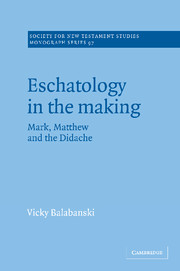Book contents
- Frontmatter
- Contents
- Preface
- List of abbreviations and note on texts
- Introduction
- 1 An imminent End? Models for understanding eschatological development in the first century
- 2 Matthew 25:1–13 as a window on eschatological change
- 3 Mark 13: eschatological expectation and the Jewish War
- 4 The Judean flight oracle (Mark 13:14ff) and the Pella flight tradition
- 5 Matthew 24: eschatological expectation after the Jewish War
- 6 Didache 16 as a development in Christian eschatology
- Conclusion
- Bibliography
- Index of modern authors
- Index of biblical and other ancient texts
- Subject index
1 - An imminent End? Models for understanding eschatological development in the first century
Published online by Cambridge University Press: 04 September 2009
- Frontmatter
- Contents
- Preface
- List of abbreviations and note on texts
- Introduction
- 1 An imminent End? Models for understanding eschatological development in the first century
- 2 Matthew 25:1–13 as a window on eschatological change
- 3 Mark 13: eschatological expectation and the Jewish War
- 4 The Judean flight oracle (Mark 13:14ff) and the Pella flight tradition
- 5 Matthew 24: eschatological expectation after the Jewish War
- 6 Didache 16 as a development in Christian eschatology
- Conclusion
- Bibliography
- Index of modern authors
- Index of biblical and other ancient texts
- Subject index
Summary
The problem of the delay of the parousia: a modern construct?
There are indications in the canon of the New Testament and in early extra-canonical sources that the delay of the parousia of Christ presented the early church with an eschatological and theological problem.
In modern scholarship the delay of Christ's return and the presumed disappointment it engendered has been seen as a primary factor, and in some cases as the primary factor, in the development of Christian eschatology. The systematic theologian M. Werner stated in his work The Formation of Christian Dogma that ‘the longer the non-fulfilment of the Parousia of Christ and the final events connected therewith continued, the weaker became the conviction that the End of the world would come in the Apostolic Age and that the Death and Resurrection of Jesus had, correspondingly, a fundamental eschatological significance’. The problem is thus seen not simply as one of eschatology, but of the fundamentals of christology.
It is perhaps not surprising, therefore, that this problem has received much attention from biblical and systematic scholars over the past century. I will begin by giving an overview of ways in which modern scholarship has sought to deal with the challenge of this problem: by embracing it as the exegetical and systematic key to developments in the early church, by rejecting it as such, or by seeking alternative approaches.
The modern development of studies in New Testament eschatology began with J. Weiss' work Jesus' Proclamation of the Kingdom of God.
- Type
- Chapter
- Information
- Eschatology in the MakingMark, Matthew and the Didache, pp. 4 - 23Publisher: Cambridge University PressPrint publication year: 1997

